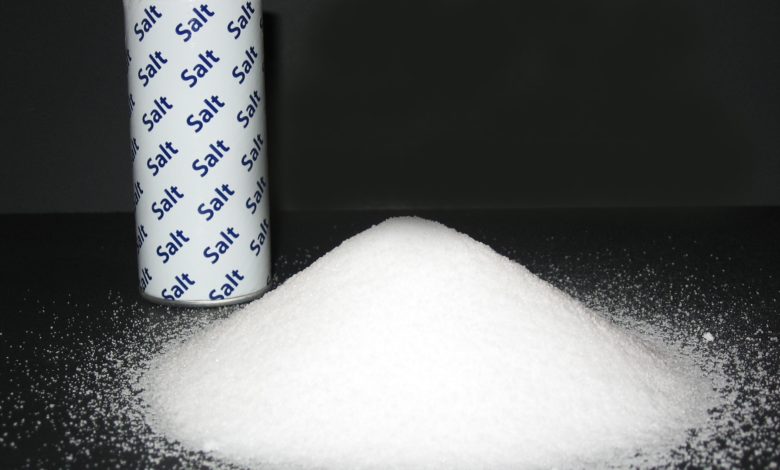Reducing sodium intake significantly lowered blood pressure in as little as one week

[ad_1]
Research Highlights:
- A randomized trial comparing the effects of high-sodium and low-sodium diets on blood pressure in adults with normal blood pressure and high blood pressure found that following a low-sodium diet significantly lowered blood pressure in 70%-75% of participants in as little as one week, including people currently taking blood pressure medications.
- Systolic blood pressure was significantly lowered by 7-8 mm Hg for participants following a low-sodium diet in comparison to those following a high-sodium diet, and by 6 mm Hg for the low-sodium group compared with their usual diet.
 Embargoed until 3:45 p.m. ET, Saturday, Nov. 11, 2023
Embargoed until 3:45 p.m. ET, Saturday, Nov. 11, 2023
(NewMediaWire) – November 11, 2023 – PHILADELPHIA — Reducing daily sodium intake by around 4,000 mg/day significantly lowered systolic blood pressure in more than 70% of adults, ages 50 to 75, in as little as one week compared to their usual diet, according to late-breaking science presented today at the American Heart Association’s Scientific Sessions 2023. The meeting, Nov. 11-13, in Philadelphia, is a premier global exchange of the latest scientific advancements, research and evidence-based clinical practice updates in cardiovascular science. The full manuscript is also simultaneously published today in The Journal of the American Medical Association.
“High blood pressure is the most common chronic disease condition in the world, and for the majority of adults, dietary sodium intake influences blood pressure,” said Deepak K. Gupta, M.D., M.S.C.I., FAHA, associate professor of medicine and director of the Vanderbilt Translational and Clinical Cardiovascular Research Center in the division of cardiovascular medicine at Vanderbilt University Medical Center, in Nashville, Tennessee. “However, dietary sodium recommendations are debated in part due to the variability in blood pressure response to sodium consumption from food.”
Researchers measured participants’ blood pressure while on their usual diets, then conducted a randomized trial in these same participants to understand how variation in dietary sodium between higher- and lower-sodium intake may relate to changes in blood pressure.
The study included more than 200 adults, ages 50-75 years, from the Coronary Artery Risk Development in Young Adults (CARDIA) study as well as other individuals. Participants were randomized to either a high-sodium diet with 2,200 mg of sodium added to their usual daily diet, or a low-sodium diet with a total of 500 mg sodium daily for one week. Participants then switched to the opposite diet for one week. Participants’ blood pressure was measured over a 24-hour period on the last day of each diet.
The results found that one week of the low-sodium diet significantly lowered systolic blood pressure in nearly 75% of adults. Additional results:
- The median systolic blood pressure measurements were 125-, 126- and 119-mm Hg for the usual, high- and low-sodium diets, respectively.
- Systolic blood pressure was significantly lowered by 7-8 mm Hg for participants while following the low-sodium diet compared with participants in the high-sodium group and by 6 mm Hg compared with participants following their usual diet. These reductions in systolic blood pressure are comparable to the reductions attained with a common, first-line medication for hypertension.
- The usual diet for most individuals was already very high in sodium at approximately 4,500 mg/day. Participants’ systolic blood pressure was not significantly greater with the high-sodium diet compared with usual diet.
- In contrast, returning to a high-sodium diet did raise blood pressure when starting from the low-sodium reference point.
“These results indicate that lowering blood pressure through dietary sodium reduction can be achieved safely and rapidly within one week,” Gupta said. “Our study also supports the American Heart Association’s position that consuming excess sodium beyond recommended levels is associated with increasing blood pressure.”
Additionally, the effect of reduction in dietary sodium on blood pressure was consistent across individuals with normal blood pressure, treated high blood pressure, and untreated high blood pressure.
“This reinforces the importance of reductions in dietary sodium intake to help control blood pressure, even among individuals already taking medications for hypertension,” Gupta said. “Just as any physical activity is better than none for most people, any sodium reduction from the current usual diet is likely better than none.”
Trial background and details:
- In contrast to several of the largest prior studies examining the effect of dietary sodium on blood pressure, the trial included individuals taking medications for high-blood pressure as well as people with diabetes (Type 1 or Type 2 not collected), the researchers noted.
- At the start of the study, about one-quarter of the 213 participants had normal blood pressure, 20% had controlled high blood pressure, 31% had uncontrolled high blood pressure and the remaining 25% had untreated high blood pressure. Approximately 1 in 5 participants had diabetes.
- 73% of participants were from the CARDIA study. Other participants were adults in Birmingham, Alabama, and Chicago, Illinois. Participants were ages 50 to 75 years, 65% were women, and 64% were Black adults.
- The low-salt diet included food and drinks provided by the researchers and daily meal plans. Sample breakfasts included oatmeal, Greek yogurt and grapes; sample lunches included fruit, a bag of chips and either a chicken salad, lentil soup or peanut butter and jelly sandwich; and sample dinners included fruit, a bottle of 1% low-fat milk and either a low-sodium frozen burrito, low-sodium frozen vegetable lasagna or a low-sodium rice and vegetable entree.
- Participants on the high-sodium diet added 2,200 mg of sodium to their regular daily diet — by consuming two chicken bouillon packets daily, with 1,100 mg of sodium each, as provided by the researchers.
- The median estimated total daily sodium intake for people on the high-sodium diet was 5,000 mg/day.
- People on the low-sodium diet had a median, 24-hour urine sodium level of approximately 1,300 mg, suggesting that some individuals consumed sodium outside of the food and drink provided.
The United States Department of Agriculture’s Dietary Guidelines for Americans 2020-2025 recommends adults should consume less than 2,300 mg of sodium daily, however, it’s estimated that adults in the U.S. typically consume about 50% more sodium, or about 3,400 mg/day. The American Heart Association recommends no more than 2,300 mg of sodium/day and moving toward an ideal limit of no more than 1,500 mg/day for most adults.
According to Gupta, all the items on the low-sodium diet menu were commercially available in grocery stores and online retailers, therefore, it is possible for people to achieve a similar diet low in sodium without participating in a clinical trial.
The investigators noted limitations of their study. Researchers did not observe patients eating the foods on each prescribed menu, in an effort to reflect “real-life” conditions, therefore, there may have been variability in sodium intake; and the dietary interventions were of one-week duration, meaning the study design did not address the long-term sustainability of the low-sodium diet or its effect on blood pressure. In addition, the results may not be generalizable to populations with different demographics than the study group, Gupta noted.
Co-authors, disclosures and funding sources are listed in the abstract.
Statements and conclusions of studies that are presented at the American Heart Association’s scientific meetings are solely those of the study authors and do not necessarily reflect the Association’s policy or position. The Association makes no representation or guarantee as to their accuracy or reliability. Abstracts presented at the Association’s scientific meetings are not peer-reviewed, rather, they are curated by independent review panels and are considered based on the potential to add to the diversity of scientific issues and views discussed at the meeting. The findings are considered preliminary until published as a full manuscript in a peer-reviewed scientific journal.
The Association receives funding primarily from individuals; foundations and corporations (including pharmaceutical, device manufacturers and other companies) also make donations and fund specific Association programs and events. The Association has strict policies to prevent these relationships from influencing the science content. Revenues from pharmaceutical and biotech companies, device manufacturers and health insurance providers and the Association’s overall financial information are available here.
Additional Resources:
About the American Heart Association
The American Heart Association is a relentless force for a world of longer, healthier lives. We are dedicated to ensuring equitable health in all communities. Through collaboration with numerous organizations, and powered by millions of volunteers, we fund innovative research, advocate for the public’s health and share lifesaving resources. The Dallas-based organization has been a leading source of health information for nearly a century. Connect with us on heart.org, Facebook, X or by calling 1-800-AHA-USA1.
###
For Media Inquiries and AHA Expert Perspective:
AHA Communications & Media Relations in Dallas:
John Arnst:
For Public Inquiries: 1-800-AHA-USA1 (242-8721)
heart.org and stroke.org
[ad_2]




